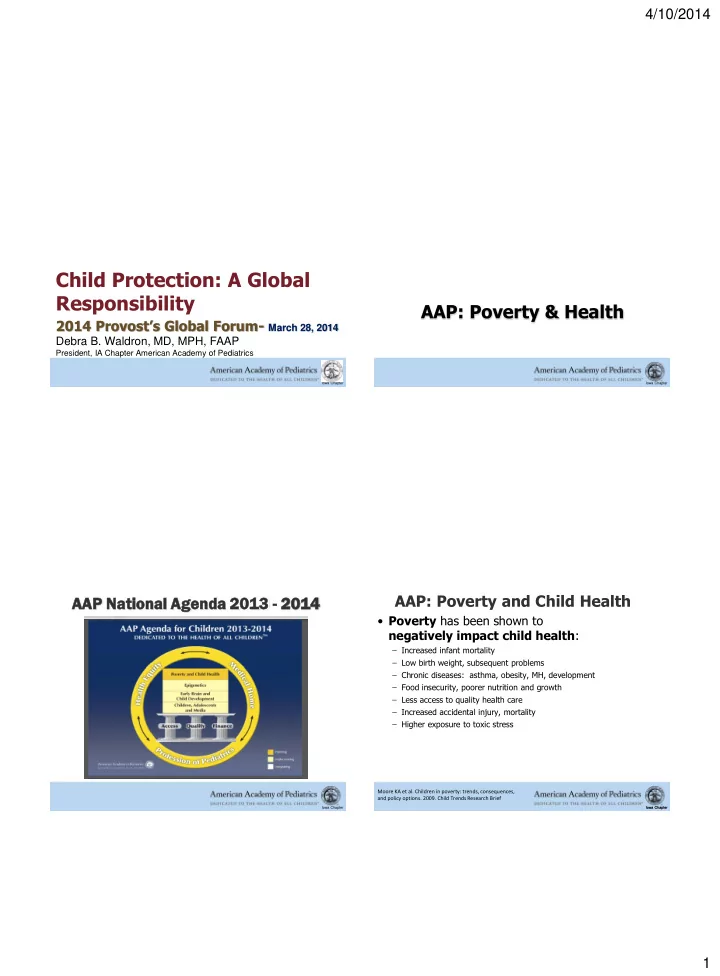

4/10/2014 Child Protection: A Global Responsibility AAP: Poverty & Health 2014 Provost’s Global Forum - March 28, 2014 Debra B. Waldron, MD, MPH, FAAP President, IA Chapter American Academy of Pediatrics Iowa Chapter Iowa Chapter AAP: Poverty and Child Health AAP P Nati tion onal al Agen enda a 2013 - 2014 • Poverty has been shown to negatively impact child health : – Increased infant mortality – Low birth weight, subsequent problems – Chronic diseases: asthma, obesity, MH, development – Food insecurity, poorer nutrition and growth – Less access to quality health care – Increased accidental injury, mortality – Higher exposure to toxic stress Moore KA et al. Children in poverty: trends, consequences, and policy options. 2009. Child Trends Research Brief Iowa Chapter Iowa Chapter Iowa Chapter 1
4/10/2014 AAP: Poverty & Child Health Poverty and Well-Being • Families in poor & low-income • Poorer educational outcomes households have difficulty – Low academic achievement, – meeting basic needs that are higher HS dropouts crucial for healthy child • Less positive social and development – accessing health care services emotional development • More problem behaviors • In United States 2012: – Early unprotected sex with – 22% children under 18 lived increased teen pregnancy in poverty (16M) – Drug and alcohol abuse – 45% children under 18 lived – Increased criminal behavior as in low income households adolescents and adults Brooks-Gunn J and Dunan GJ. (1997). Effects of poverty on children. • More likely to be poor adults Future of Children 7: 55-71. Annie E. Casey Foundation, KIDS COUNT Data Center, www.kidscount.org Iowa Chapter Iowa Chapter Iowa Chapter Iowa Chapter AAP Policy Statements & Pubs re: What AAP is Impact of Poverty on Health Doing about Current policies include: Poverty and Child • Providing Care for Children and Adolescents Facing Health Homelessness and Housing Insecurity • Medicaid Policy Statement Policy • Early Childhood Adversity, Toxic Stress, and the Role of the Pediatrician: Translating Developmental Advocacy Science into Lifelong Health Research • The Importance of Play in Promoting Healthy Child Programs & Development and Maintaining Strong Parent-Child Education Bond: Focus on Children in Poverty Iowa Chapter Iowa Chapter Iowa Chapter 2
4/10/2014 Advocacy for Families Advocacy for Families • Nutrition • Access to Health Care – Healthy Hunger-Free Kids – Medicaid/EPSDT, CHIP, ACA Act of 2010 • Early Education and Child Care – Supplemental Nutrition Assistance Program – Head Start and Early Head Start • Income Support – Child Care and Development Block Grant – Minimum wage – Preschool Investment – Welfare reform • Public health approach • Maternal and Child to address toxic health Health Services Iowa Chapter Iowa Chapter Iowa Chapter Iowa Chapter AAP Practices: EBCD Principles Practices: What Can Pediatricians Do? • Child development – foundation for • Apply eco-bio-developmental framework community, economic development • Brains built over time, better on solid foundation • Brain development integrated – social, emotional, learning skills closely connected • Toxic stress disrupts brain development • Positive parenting can buffer toxic stress • Creating right conditions in early childhood has critical long-term benefits Iowa Chapter Iowa Chapter Iowa Chapter 3
4/10/2014 Practices: What Can Pediatricians Do? Practices: What Can Pediatricians Do? • Connect families to local resources Educate/Train Parents Educate/Train Providers • ACEs and effects • Whole child development • Recognize and encourage • Aces and effects rudimentary foundational • Educate re: trauma- Family-Centered, skills as they emerge informed care Community-Based • Ensure the brain’s wiring is – Address needs of child right the first time System of with significant • Children are biologically Services behavioral problems predisposed to more related to traumatic physiologic stress and critical life experiences brain structures that modulate stress mature later • Resiliency skills Perrin JM et al. Arch Pediatr Adolesc Med 2007;161:933-936. Iowa Chapter Iowa Chapter CHSC Vision WHAT IS TITLE V ? Maternal and Child MCH History Health Block Grant MISSION : to Who we serve : IA improve the children & youth birth Only federal program • Enacted in 1935 as a part health, through 21 who have devoted solely to of the Social Security Act development, and a chronic condition improving the health of all well-being of (physical, • Nation’s oldest Federal- women and children children and youth developmental, State partnership with special health behavioral, or care needs in emotional) or have • Functioning over 75 partnership with an increased risk for years families, service chronic condition and providers, who have a need for • Title V converted to a communities, and special services. Block Grant Program in policy makers. 1981 Iowa Chapter Iowa Chapter Iowa Chapter 4
4/10/2014 Partnering with family-support CHSC Key Facts organizations • Title V Program for CYSHCN • 13 Regional Centers • 163,488 CYSHCN (22.7%) Iowa Chapter Iowa Chapter Summary • Alarming rates of chronic health conditions among children/youth Thank nk you! • Poverty persists among American children – Major impact on child health and development • Much evidence supports importance of early Iowa AAP Chapter : childhood Debra Waldron, MD, MPH, FAAP – Negative experiences have lasting effects President, AAP, Iowa Chapter • Family-centered community health care linked with debra-waldron@uiowa.edu other community services can meet common elements in these priorities Iowa Chapter Iowa Chapter Iowa Chapter 5
Recommend
More recommend